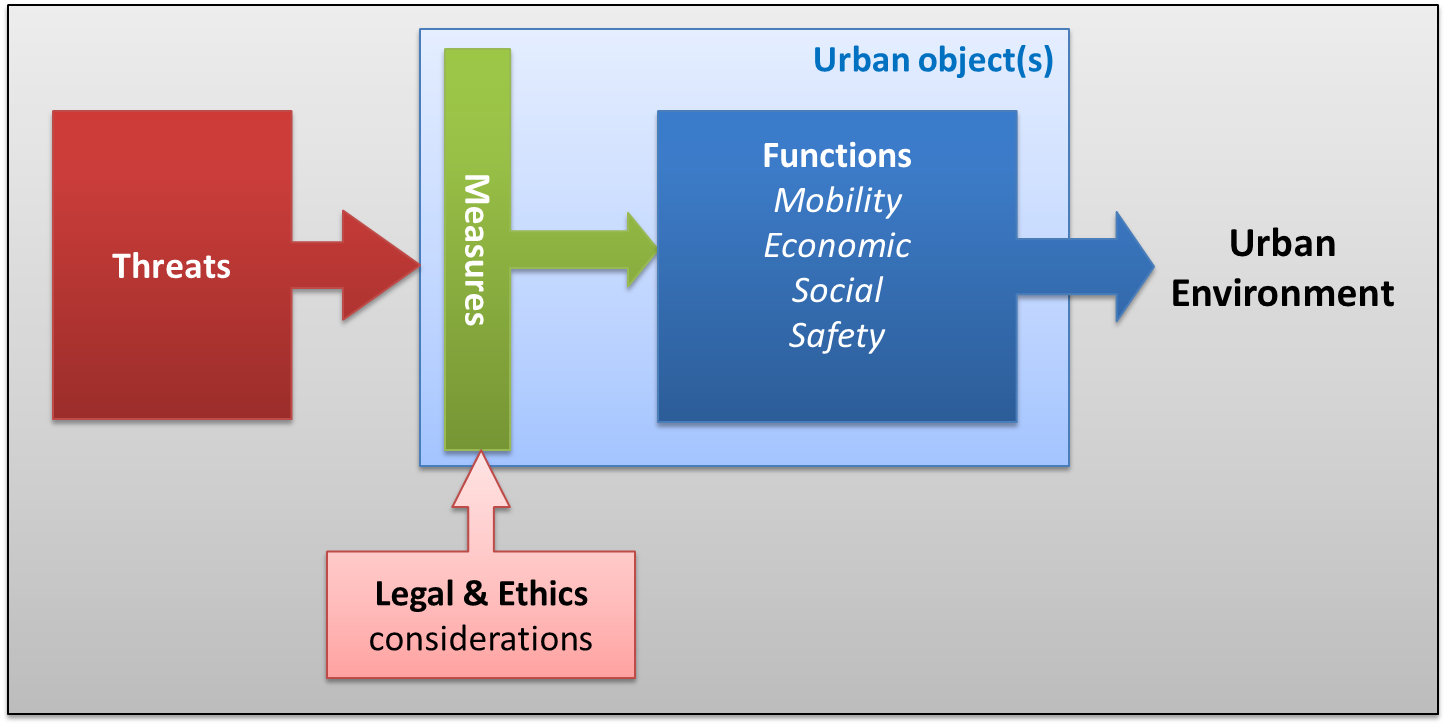Structure of the knowledge base
The Urban Securipedia is a knowledge base which is structured around a number of concepts which are essential to local government and other organisations responsible for or involved in the safety and security of people and objects in the urban area (such as urban planners, event planners or Law Enforcement Agencies) in order to include security consideration in their urban planning process.
Contents
Description
Urban Securipedia is one of two inter-related components of computer assisted support for local government and other organisations responsible for or involved in the safety and security in urban areas (for example urban planners), to support decision-making with regard to the security of cities concerning concrete problems or goals. Each component, namely the Knowledge Base (i.e. this Urban Securipedia) and the Risk Assessment tool (SecuRbAn), work closely together, thus supporting the urban planner in ways that are described in the when to use page. The how to use page provides a concise step-by-step guide to the use of the tools. Further assistance with the use of the tools can be found in the accompanying SecuRbAn manual.
The information included in the Securipedia concerns both pages that are directly in support to the security of urban areas, the urban planning process and pages that are included to support the use of the tools. Each of these types and their contents will be discussed in the following paragraphs.
Pages in direct support of the urban planning process
The central concepts that are included in this knowledgebase that are in direct support of the urban planning process, concern the following categories:
- Pages on specific security issues;
- Pages on specific types of measure;
- Pages on specific urban objects (object types);
- Pages on specific issues in other expert fields that are related to security;
The structure in which these pages are included, is graphically depicted in the clickable figure below.
The urban object
Central in the knowledge base is the object that the urban planner is developing. This object can be a single building or a more overarching critical infrastructure, but might also entail the renovation of a complete quarter of a city.
The urban environment
The urban object will be situated in, and indeed part of, an urban environment. The urban environment is an important aspect of the planning process of the urban object.
Functions
This object has to provide in certain functions, such as mobility functions for a new bridge, economic functions for a mall, social functions for a stadium or safety and security functions such as protection for the elements or privacy for almost all types of buildings. These functions can both be distinguished for the object itself, and for its surroundings. These functions also interact: the mobility function of a bridge can for instance contribute to the economic function of the city. As these interactions are important to keep in mind when looking at the security aspects of urban planning, these functions are categorized and described in this knowledge base.
Threats
The urban object is designed to fulfil these functions according to the requirements. However, the fulfilling of these requirements can be frustrated by the actions of persons who seek to do harm. These are divided up in safety threats and security threats. This is why the knowledge base will also provide information about the various types of threats, their motivation (motives) and the means they have to their disposal to succeed in their intentions.
Mitigative measures
The only means at the disposal of the urban planner to mitigate the threats, is to take mitigatory measures (for mitigation see also crisis management cycle). These are provisions taken to lessen the chance of success or impact of an attack. The knowledge base will contain information about measures in order to know which measures might be effective against what threat.
Legal and ethical restrictions
The urban planner does not have unlimited liberty in the measures he is allowed to take. These are subject to legal and ethical restrictions that enforce additional requirements to the measures that are feasible. This is why in this knowledge base, also information about the legal an ethical requirements is included.
EU prevention strategies
The knowledge base also is a place for more information on EU prevention strategies in general, including an overview of projects related to Urban Security and specific updates from the EU ISFP PRoTECT project in 2018-2021.
Interconnectedness
The knowledge base intents to show the interconnectedness between all these concepts in a practical, applicable way that directly supports the integration of this knowledge in the urban planning decision process right from the start.
Pages in support of the use of the tools
Types of pages that included in the Securipedia that are included to provide support for th euse of the tools, concern the following categories:
- Support pages for SecuRbAn questions;
- General pages and support pages introducing the use of the Securipedia tool component; and,
- Pages providing background (support in the interpretation of expert terms and constructs) on each field of expertise.
The direct relation of the information on these pages with the urban planning process can therefore be obscure. To communicate to the reader the nature of the page, we marked these pages with an icon in the top right (as can be seen on the top right of this very page). The icons we use are:
| Icon | Page type |
|---|---|
| Support page for the SecuRbAn tool | |
| Support page for the Securipedia | |
| Page providing background on specific field of expertise |

